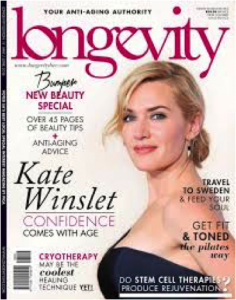Post by HLTD51 student KRIS
In Teresa Brennan’s essay, Social Physics (in Woodward’s Figuring Age: Women, Bodies, Generations), she reveals a (somewhat unsettling) analogy of aging made by Sigmund Freud. Freud, the renowned founder of psychoanalysis, described the aging process as the slow formation of an “inorganic crust” which consumes the body over time.

Kate Winslet on the cover of Longevity Magazine (2016), which advises women on how to maintain a youthful appearance
This comparison is mirrored in the ways that public discourse others the processes of aging – the changes that aging subjects the once-familiar body to. The “crust” of age creeps up and wrinkles, sags, warts, discolours, and weakens us. This is portrayed in the anti-aging campaigning of the beauty industry, which effectively capitalizes off of the anxiety provoked by the impending onslaught of crust. “Skin looks visibly more youthful after one use; fight fine-lines and wrinkles”— the aging are advised to prevent this crust from forming, at risk of losing their young, true, form. I can attest to this as a former skincare sales consultant.
I was disheartened by my clients’ desperation to prevent what is imminent. “I just need something that will work,” many would groan, and I was unsure how to inform them that no face cream on Earth will freeze the hands of time. I watched with pity as clients would point in frustration to their “trouble spots” and frown at their reflection in the mirror. Pity, not because I was mourning their wrinkles and crow’s feet — but pity for the catastrophe made of their physical aging.
The need to avoid this crust was consistently pressing across clients of different races and ethnic groups. I watched in awe as women would pick up jars of moisturizer by the dozen to make sure they didn’t run out. Some would trust my word enough to buy an entire line of a product without even trying it or asking the price. Such were the lengths to which people would go in order to look youthful, or at least “slow down the aging process”. If they approved of a product’s results, they returned later with their mothers, sisters, cousins, and daughters, to upkeep a familial tradition of aging well.
*
TK Matunda’s reflective essay Coconut Oil and the Contradictions of Time both mirrors and adds to my experience. Where Freud may liken processes of wrinkles and thinning hair to the formation of inorganic crust, Matunda imagines them as “terrible afflictions — curses that take the body hostage.”
Pity was activated in me once more as I began to read Matunda’s piece, which she opens by describing the paradox of her ideal aging process: to be distinguished intellectually by the wisdom that comes with aging, but to appear untouched by age at face value. But the text takes an interesting twist when she describes her twenty-minute moisturizing regime, during which she smooths her skin with coconut oil as a defense against aging.
More than just oil on skin, this regime was self care. This was Matunda consciously delegating time to focus on herself, which is increasingly difficult with age, particularly for Black women (see this brief piece on why self-care is a radical act when performed by Black women).
With this, I realized that the pity and shock I felt as a response to my client’s purchases was based on the assumption that they followed their beauty regimes begrudgingly. The use of these products for genuine self care had been presented to me, but I chose not to focus on it. I remember clients boasting, “Everyone asks me what my secret is. I tell them it’s because I take such good care of my skin.” I observed the sense of pride that they gained from having soft, pleasantly-scented skin.
*
I see now that this culture surrounding health and beauty merchandise has a silver lining beyond the fear of decay. Perhaps there is empowerment behind my clients’ shea butter and essential oils. For instance, a new skincare routine could be a way of exercising agency and proactively engaging in (what one may perceive as) health promotion. This act may activate self-efficacy and inspire the individual to pursue other activities with scientifically-backed health-promoting effects (such as a new hobby or eating more nutrient-dense foods). For some, like Matunda, being able to slow down and focus on something simple, something manageable: oil on skin, is therapeutic in itself in a world where control over our surroundings is limited.
All of this is to say that although the motivation behind anti-ageing routines does seem to be based in preventing an almighty, calamitous crust from forming upon us, our preventive processes may bear some good. Rather than frowning upon the ill self-esteem of the ageing when they take these measures to look more youthful, it is crucial to consider that there is likely more being gained than just supple skin.